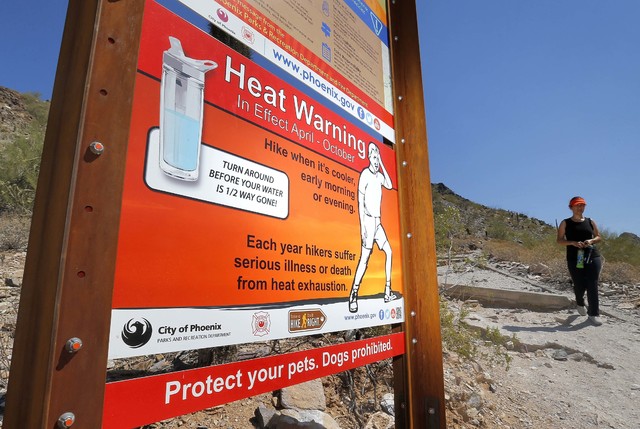TUCSON, Ariz. (AP) — Last year, a French couple died while trying to make sure their young son had enough water on a broiling summertime outing in a New Mexico national park.
TUCSON, Ariz. (AP) — Last year, a French couple died while trying to make sure their young son had enough water on a broiling summertime outing in a New Mexico national park.
Over the weekend, two Germans visiting Tucson for a conference succumbed to the record-breaking heat after taking a hike.
Amid a string of heat-related deaths — and another staggering heatwave — officials in the U.S. Southwest are increasing their efforts to alert visitors to the perils of being outdoors in extreme heat.
Local governments and businesses are improving signage and brochures, including making warnings and vital information available in different languages. They’re also educating hotel staff on what to tell tourists with plans for the outdoors.
But it’s not just those from out of town at risk. Most people who end up dying or needing to be rescued when the temperature soars are locals who ignore warnings, law enforcement officials say.
At Death Valley National Park, where thousands flock to experience the hottest place on Earth, large red signs warn visitors to be careful in the extreme temperatures.
But that hasn’t kept people from trying to hike, and the park in California and Nevada has seen its share of rescue operations.
Dan Kish, a park guide, says an operation last year included rescuing a tourist who had walked past a giant red sign that read “STOP. Extreme heat danger.”
At New Mexico’s White Sands National Monument, park officials have posted new signs aimed at people who speak different languages following the French couple’s deaths last year.
David Steiner, 42, and his wife, Ornella Steiner, 51, likely saved their 9-year-old son’s life by giving him two sips of water for each one they took before the supply ran out, officials say.
The park has installed new signs that include Celsius in addition to Fahrenheit and more graphics instead of text, ranger Rebecca Burghart said. About 10 percent of White Sands visitors are from foreign countries, and the park wanted to make signage more accessible for people who don’t speak English, Burghart said.
The park’s website and newspaper are available in seven languages. Burghart said the new signs were in progress before the French couple died last year.
“So it doesn’t matter what language, it’s modeling the correct behavior, making those messages more universal,” she said.
In Arizona, it’s not just about the warning signs posted at most trailheads. Officials also are working more closely with resorts and hotels to educate concierge and other staff on what to say to tourists when they want to hike in the heat.
The city of Phoenix launched a new initiative with local hotels that includes brochures about hiking safety for concierges to hand out. Camelback Mountain has the most popular of the city’s 41 trailheads, drawing up to a million visitors each year from all over the country, especially in the spring.
“People come and visit, and you see Camelback is on their bucket list,” Parks and Recreation spokesman Gregg Bach said. “We had seen an increase in rescues, and many of those rescues were people who were just flat-out unprepared to be hiking.”
City firefighters have responded to more than 200 rescue calls at Phoenix trails in the past year, Bach said. The city has also launched a local campaign called “Take a hike. Do it right” that aims to reduce injuries and deaths by providing more details about hiking trails.
The city has considered suggestions that it close trails when it gets too hot but is taking a more educational approach, Bach said. The city runs 200 miles of trails, and closing them would require a lot of resources, he said. It also wouldn’t guarantee people would stay away.
At the JW Marriott Tucson Starr Pass Resort & Spa in Tucson, concierge staff advises visitors who want to hike to do it early in the morning or in the evening. The resort offers free guided hikes daily at 6 a.m., and staffers warn people about how dangerous it can be to hike when it’s hot, concierge Ange Silvestre said.
When asked whether deputies should be posted at trailheads to stop hikers in extreme heat, Pima County Sheriff Chris Nanos said that’s not a viable option.
Nanos said that while many hikers who need rescue or are killed are foreigners, 80 percent are locals who ignore warnings.
Six people died in Arizona on Sunday during an extremely hot day. Two were local residents, including a 28-year-old fitness trainer and experienced mountain biker who died of heat-related illness after a ride.
“The problem is, we can only advise you,” Nanos said. “You just gotta be smarter than that.”

